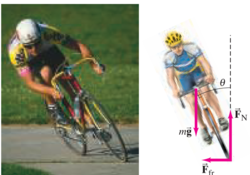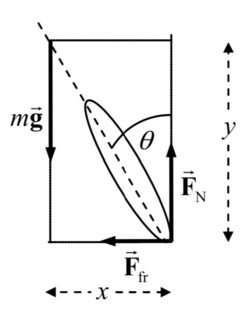Chapter 11 Problem 78
Problem
A bicyclist traveling with speed m/s on a flat road is making a turn with a radius m. The forces acting on the cyclist and cycle are the normal force () and friction force () exerted by the road on the tires and , the total weight of the cyclist and the cycle.
(a) Explain carefully why the angle the bicycle makes with the vertical must be given by if the cyclist is to maintain balance
(b) Calculate for the values given. [Hint: Consider the "circular" translational motion of the bicycle and rider.]
(c) If the coefficient of static friction between tires and road is 0.65, what is the minimum turning radius?
Solution
(a)
The net torque on the cyclist about an axis through the CM must be zero in order not to fall.
(b)
The cyclist is not accelerating vertically, so . The cyclist is accelerating horizontally, because he is traveling in a circle. Thus the frictional force must be supplying the centripetal force, so .
(c)
The smallest turning radius results in the maximum force. The maximum static frictional force is


















